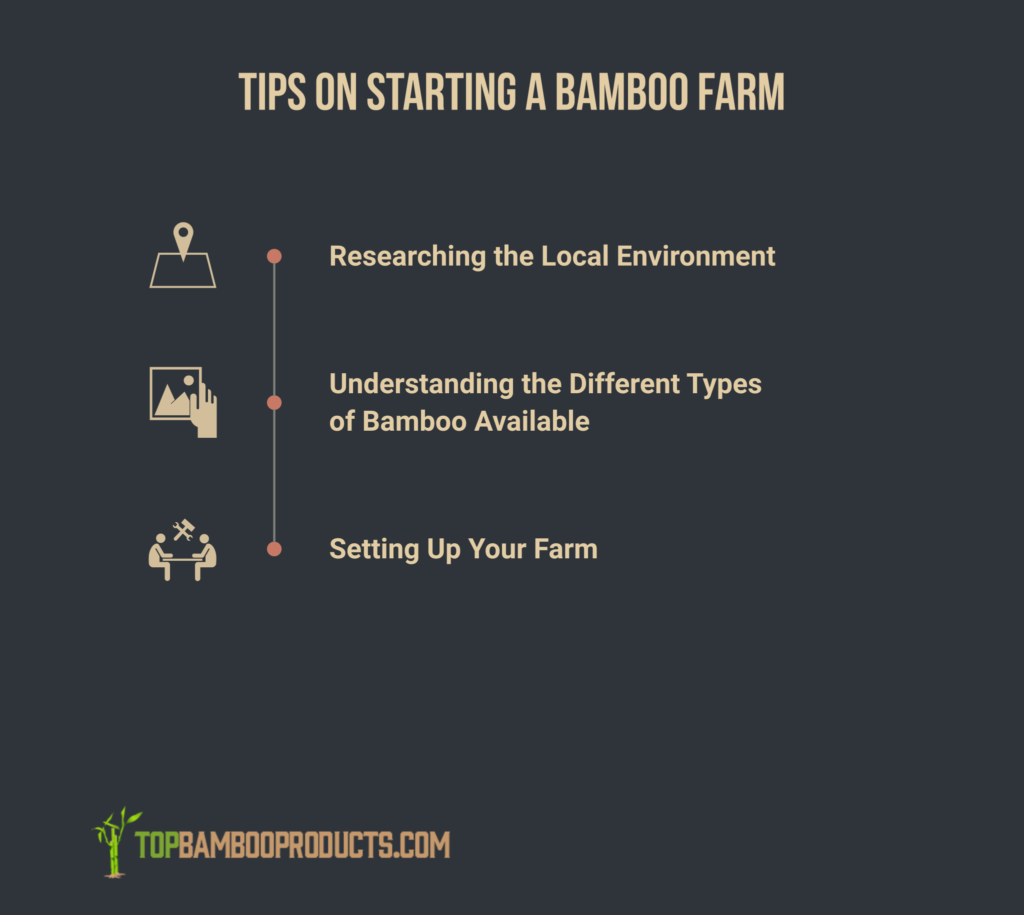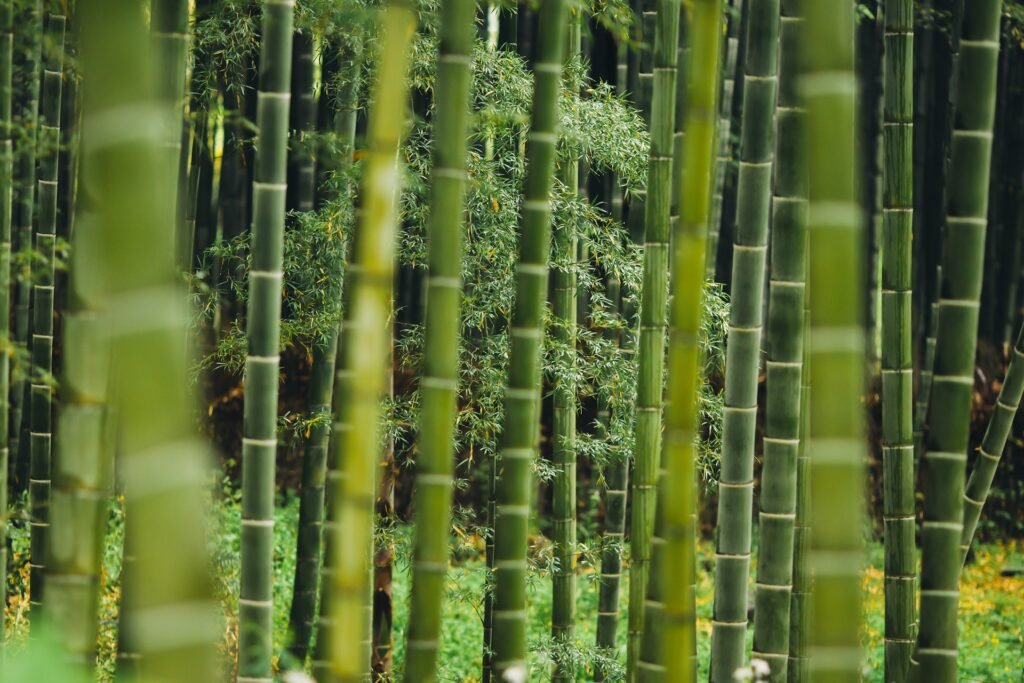Taking The Plunge: How To Start A Bamboo Farm
0Shares
Bamboo farming is an exciting and rewarding venture that can bring your property to life. With the right knowledge and resources, you can create a thriving business by growing and harvesting bamboo. But before you take the plunge into becoming a bamboo farmer, there are some crucial steps to consider to get started. In this article, we’ll look at how to start a bamboo farm and how to make it successful.
What Exactly Is a Bamboo Farm?

For starters, a bamboo farm is an area devoted to growing bamboo. Different types of bamboo can be grown in various climates, and each has its own unique characteristics that make them suitable for different uses. Bamboo farms are great for providing lumber and raw material for construction or manufacturing. Still, they also have many environmental benefits, such as reducing carbon dioxide emissions from deforestation and providing habitats for wildlife.
The bamboo farming business has become increasingly popular in recent years due to its numerous benefits. In addition to the environmental impact, bamboo is also used for furniture, flooring, and other building materials. It can even be used as a garden or landscape design ornamental feature.
How to Start a Bamboo Farm

Now that you know what a bamboo farm is and why it’s important, let’s look at how to start one.
☑Researching the Local Environment
Before you start a bamboo farm, it’s essential to consider the local environment. Factors such as temperature, rainfall, and soil type affect how well your plants will grow. You’ll also need to research what types of bamboo are best for your local climate, as some varieties may be better suited than others.
For example, the temperate climates of North America and Europe tend to be best suited for hardy-clumping bamboo species. At the same time, tropical and subtropical regions are more suitable for running bamboo. It’s also important to research any existing local regulations that may affect your farm and any potential pests or diseases that could affect your crop.
☑Understanding the Different Types of Bamboo Available
Over 1,000 different species of bamboo are available for cultivation worldwide. Each type has unique characteristics that make it suitable for various applications and environments. For example, some types of bamboo can grow up to a meter in height, while others may be as tall as 30 meters!
When selecting which type of bamboo to grow on your farm, it’s essential to consider each species’ size and growth habits. Make you understand how much room each type of bamboo requires for spread, as this will determine how many plants you can fit on your land. It’s also a good idea to research any potential pests or diseases that could affect your crop and any local regulations that may affect your farm.
☑Setting Up Your Farm
During site selection, it’s important to consider factors such as soil type, temperature, rainfall, and available space. Depending on the species you choose to grow, some may require larger land areas than others.
In addition to considering the land, you’ll also need to apply for any necessary permits and licenses to operate a bamboo farm legally. Depending on where you live, this may involve filing paperwork with the local government or other organizations. Knowing what permits and licenses are required before you begin is important, as failure to obtain the necessary documents could result in hefty fines or even criminal charges.
Once you have all of your required paperwork in order, you can start planning out the layout of your farm and finding suppliers for your bamboo plants.
These are the primary steps to consider when starting a bamboo farm.
How to Choose the Right Bamboo Supplier
Now that you better understand what’s involved in setting up a bamboo farm, it’s time to find the right suppliers for your plants. Not all bamboo suppliers are equal, so it’s essential to research before making any decisions.
Here are some factors to consider when selecting a bamboo supplier:
✅Quality
Be sure to check the quality of the plants any potential suppliers offer. Ensure they’re healthy and free from disease or pests that could harm your crop.
✅Price
A good bamboo supplier should offer competitive product prices without compromising quality. Compare prices between different suppliers to ensure you get the best deal possible.
✅Variety
Different types of bamboo may require different growing conditions and nutrients, so it’s important to ensure that your supplier offers a wide variety of species.
✅Expertise
A reputable supplier should have extensive experience in the bamboo industry and be able to provide helpful advice and guidance.
✅Reputation
Before selecting a supplier, check online reviews and feedback from other customers who have used their services. This will give you an idea of what kind of service you can expect from them.
Considering these factors, you’ll be able to find the right bamboo supplier for your farm.
Growing Bamboo on Your Farm

Since you already found the right supplier, you can now focus on growing your bamboo. It is important to follow all the instructions provided by your supplier carefully to ensure that your plants can thrive. Additionally, you must ensure that you provide them with proper care and maintenance, such as water, fertilizers, and insecticides.
👉Understanding How to Prepare the Soil and Maintain the Ideal PH
When it comes to preparing the soil for your bamboo plants, it’s important to keep in mind that they thrive in well-draining and slightly acidic soils. To achieve this, add organic matter such as compost or peat moss to the soil and fertilizers. Additionally, you should ensure that the soil’s pH is between 5.5 and 6.5, as this will help your plants absorb nutrients more efficiently.
👉Understanding How Much Water and Sunlight
Bamboo plants require a lot of water and sunlight to grow. It’s vital to ensure that your plants get at least an inch of water per week and direct sunlight for about 6 hours each day. You can supplement with artificial light if necessary, but natural light is always best.
👉Maintaining Your Bamboo Farm
So, how do you ensure your bamboo farm thrives and remains healthy in the long run? I will discuss the top farming tips and tricks for maintaining your bamboo farm.
👉Understand the Types of Bamboo You Have
As a farmer, it is crucial to understand the types of bamboo you are planting thoroughly. There are two primary categories of bamboo – clumping and running bamboo. Clumping bamboo grows in clusters, while running bamboo spreads in an expansive pattern. You will want to research your specific bamboo species and their growth patterns to ensure you give them the correct maintenance.
👉Proper Irrigation and Soil Management
Like any other plant, your bamboo farm needs proper irrigation and soil management to thrive. Bamboo typically requires a lot of water, and it is essential to ensure that the soil is always moist, not too wet, and well-drained. In addition, consider using organic fertilizers to promote its growth and health.
👉Pruning and Training
Pruning is vital to the health and growth of bamboo. Pruning encourages new growth and removes diseased and damaged culms (stems). Ensure that you remove any dead or yellowing leaves and cut back any culms that are overgrown or out of position. You may also want to train the bamboo with stakes and wires while young to prevent it from bending or breaking in the wind.
👉Weeding
Keep your bamboo farm free of weeds and unwanted vegetation. Weeds can compete with your bamboo for resources, and their presence can cause significant damage if not dealt with properly. You may want to use weed barriers, weed mats, or even manual removal to keep the weeds in check.
👉Monitor for Pests and Diseases
Lastly, keeping an eye out for pests and diseases is crucial to maintaining healthy bamboo growth. Common pests that affect bamboo include bamboo mites, bamboo mealybugs, and bamboo beetles, which can all cause significant damage if not dealt with promptly. By proactively monitoring pests and diseases, you can catch any issues early and prevent further damage.
👉Harvesting and Selling Your Bamboo
When it comes time to harvest your bamboo, you’ll want to ensure the plants are in good condition. Make sure that any dead or diseased culms and any weeds that may be affecting growth have been removed. You can sell the harvested bamboo directly to consumers or wholesale it to other businesses. Regardless, you’ll want to ensure that your bamboo is of the highest quality before you sell it.
Remember to focus on soil and irrigation, prune regularly, keep your bamboo free from weeds, and stay vigilant for pests and diseases.
Ensuring Safety While Interacting with Bamboo
Despite its many benefits and aesthetic appeal, bamboo can cause safety concerns if not handled correctly. It is, therefore, paramount to observe certain safety precautions when interacting with this versatile plant.
When planting or pruning bamboo, wearing appropriate protective gear is crucial. Thick gloves protect hands from the bamboo’s sharp edges, and safety glasses protect your eyes from potential hazards.
Bamboo culms can grow rapidly and unpredictably, so monitoring their growth frequently is essential. Overgrown bamboo poses threats such as falling onto structures or power lines, and their strong roots can cause damage to surrounding infrastructure. Regular and careful pruning can mitigate these threats.
Finally, bamboo can be an invasive species if not controlled properly. Running bamboo, in particular, can spread quickly and potentially take over other areas of your garden or neighboring spaces. If this type of bamboo is in your vicinity, consider installing a root barrier to contain its spread.
By taking these precautions, you can enjoy the benefits of bamboo farming while maintaining a safe environment.
Outreach and Marketing Strategies

Now, you are ready to start selling your bamboo products. But how do you reach out to potential buyers and inform them of the quality of your farm’s goods? Here are a few tips on marketing and outreach strategies:
⏹Utilize Social Media:
Social media can be an effective way to draw attention to your product and get people interested. Post regularly on platforms such as Instagram, Facebook, and Twitter with pictures, captions, and stories about your bamboo farm – this will help you increase the visibility of your bamboo business.
⏹Create a Website or Blog:
A website or blog is an essential tool for showcasing your products and services. You can use these platforms to inform customers about the different types of bamboo you offer, share details on where they can purchase them, and much more. Additionally, creating a website or blog will also improve your search engine rankings, making it easier for people to find you online.
⏹Network with Other Bamboo Farmers:
Networking is an important part of any business; the same is true for bamboo farming. Reach out to other farmers in your area and connect with them – this will help you build relationships and learn more about the industry. You can collaborate on projects or share resources that can benefit both parties.
⏹Advertise Locally:
Local advertising is a great way to spread the word about your farm and its products. Consider placing advertisements in local newspapers, magazines, and radio stations – this will help you connect with potential customers interested in your bamboo offerings.
⏹Hold Events:
Events are an excellent way to showcase your product and create an opportunity for people to interact with it. Hosting a farm tour or open house can be great for introducing people to your product and allowing them to experience it firsthand. You can even host workshops on bamboo farming that will help educate potential customers on the art of this craft.
By utilizing these marketing strategies, you can generate interest in your products and establish yourself as a reputable bamboo farmer.
Calculating Start-up Costs Associated with Running a Bamboo Farm

Starting a bamboo farm can be expensive, and it is important to factor in all potential costs before beginning. Here are some of the start-up expenses that you should consider. This is just an estimated list, and costs may vary depending on your individual situation.
💸Land Purchase or Lease
The first and most crucial step to start bamboo farm is finding the right plot of land. Bamboo grows best in warm and tropical climates with fertile and well-drained soil. The land purchase or leasing cost can vary significantly depending on your location and the farm size. In the United States, agricultural land prices can range from $4,000 to $12,000 per acre. A lease agreement can reduce the upfront cost, but you must factor in the monthly or yearly rental fees.
💸Seeds or Rhizomes
Once you have secured the land, the next step is acquiring the bamboo. You can either use seedlings or rhizomes to propagate the plants. The cost of bamboo seeds or rhizomes can vary depending on the species and the supplier. On average, a packet of 50 seeds can cost around $15 to $20, while a bundle of 100 rhizomes can cost between $300 to $500.
💸Labor Costs
A bamboo farm requires significant labor for planting, maintaining, and to harvest bamboo plants. Depending on the size of the farm and the tasks involved, you may need to hire full-time or seasonal workers. The wages and benefits can vary depending on the laborers’ location, skills, and experience. On average, the hourly wage for agricultural workers in the United States is $14.46, but it can go up to $20 in some states.
💸Soil Preparation and Irrigation Equipment
Bamboo plants require fertile soil with proper drainage and adequate moisture to grow healthily. Depending on the condition of the land, you may need to invest in soil and land preparation equipment such as plows, tillers, and tractors. Irrigation systems such as sprinklers, drip irrigation, or water pumps may also be necessary to ensure proper moisture levels. The cost of soil preparation and irrigation equipment can vary depending on the size and complexity of the farm. On average, these expenses can range from $5,000 to $10,000.
💸Pest Control Products
Finally, you need to account for the cost of pest control products to protect the bamboo plants from diseases and pests. Bamboos are susceptible to insect attacks such as aphids, mites, and mealybugs. Fungi and bacteria can also damage plants. Organic or chemical-based pesticides and herbicides are available, and the cost can vary depending on the brand and quantity. On average, expect to spend $1,000 to $2,000 per year on pest control.
By considering the start-up costs and estimating the expenses, you can better understand the financial requirements and prepare accordingly. Each expense needs careful consideration, from land purchase or leasing to pest control products. However, a bamboo farm can provide steady and long-term returns with proper planning and management.
Frequently Asked Questions
How long does it take for bamboo to mature?
The time it takes for bamboo to mature can vary depending on the species of bamboo and the growing conditions. Some bamboo species can mature in as little as two years, while others can take up to ten years. Generally, most bamboo species will start to produce culms (stems) after three to four years, but it can take several more years for the culms to reach their full height and thickness.
Can bamboo be grown in containers or pots?
Yes, bamboo can be grown in containers or pots, but you need to choose the right species of bamboo and the right size of the container. The container must be large enough to support the growth of the bamboo roots and the plant itself. It is also important to regularly water the bamboo and fertilize it during the growing season.
How do I propagate bamboo?
You can propagate bamboo through division or cuttings. Division involves separating a mature bamboo plant into smaller sections and planting each separately. Cuttings involve taking a section of culm and planting it in soil. Keeping the soil moist and warm is essential until the cutting has established roots. The best time to propagate bamboo is in the spring.
Can I use bamboo for erosion control?
Yes, bamboo can be used for erosion control due to its strong, interlocking root system. When planted on a slope, the bamboo roots can help to hold the soil in place and prevent erosion. Bamboo also helps to absorb water, reduce runoff and improve soil quality.
How do I control the spread of bamboo if it becomes invasive?
While bamboo is generally easy to grow and maintain, some species can become invasive if not properly contained. To control the spread of invasive bamboo, you can use physical barriers such as root barriers or trenches to prevent the roots from spreading. Regularly prune the bamboo to keep it from spreading too far. If all else fails, you can choose to remove the bamboo completely.
Final Words
Starting a bamboo farm is a viable and lucrative endeavor for those passionate and dedicated to making it happen. While it may seem daunting at first, with the proper research, planning, and execution, anyone can turn an empty piece of land into a thriving bamboo forest. From choosing the right bamboo species to cultivating strong root systems, there are many factors to consider when starting a bamboo farm.
But the result is worth it – not only does bamboo provide countless commercial and environmental benefits, but it also offers a chance to connect with nature in a profound way. Following the guidelines and advice outlined, you can take your first steps toward creating a flourishing bamboo farm that will stand the test of time.
0Shares
